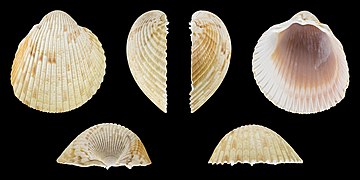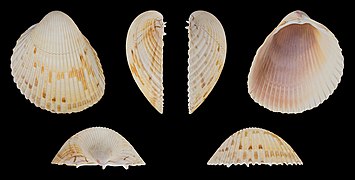| Dinocardium | |
|---|---|
 | |
| Shell of Dinocardium robustum from Florida at the Museo Civico di Storia Naturale di Milano | |
| Scientific classification | |
| Domain: | Eukaryota |
| Kingdom: | Animalia |
| Phylum: | Mollusca |
| Class: | Bivalvia |
| Order: | Cardiida |
| Family: | Cardiidae |
| Genus: | Dinocardium Dall, 1900 |
| Species: | D. robustum |
| Binomial name | |
| Dinocardium robustum (Lightfoot, 1786) | |
| Synonyms | |
| |
Dinocardium is a genus of large saltwater clams or cockles, marine bivalve molluscs in the family Cardiidae, the cockles. There is only one species in the genus, Dinocardium robustum, or the Atlantic giant cockle.



